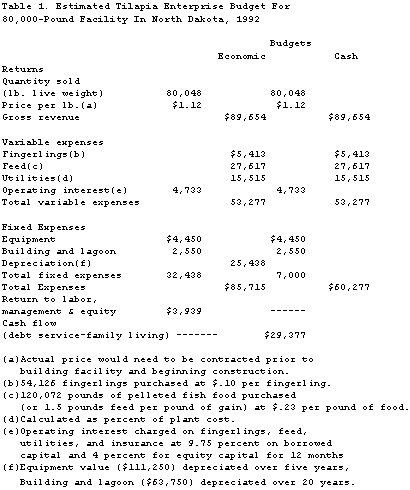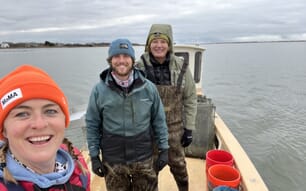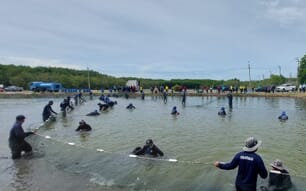Farming Tilapia - By Randy Sell, Research Assistant and Dwight Aakre, Farm Mangement Specialist, North Dakota State University - This report looks at farming Tilapia and discusses its characteristics, marketing and economic feasibility.
The aquaculture industry in the United States and North Dakota is in its infancy. Presently, the success of the industry depends largely on two factors.
First, demand for high-quality fish products is increasing. In 1989 the United States consumed a record 15.9 pounds of seafood per capita, up 5 percent -- or 3.9 billion pounds -- from 1988. Most of the fish consumed by Americans is imported. Of all products imported to the United States in 1989, the value of imported seafood was second only to that of imported petroleum.
Second, world supplies of wild fish stock are decreasing. As wild stocks continue to be depleted, aquaculture represents an alternative means to meet the increased demand for fish products. Currently, aquaculture is the most rapidly growing segment of the agricultural sector of the United States economy. The National Fisheries Institute expects to meet an annual consumption goal of 20 pounds per capita by the year 2000.
Some of the more established species currently produced on fish farms include catfish, trout and salmon. According to Andrew Davlin, Jr., an industry spokesman, aquaculture should increase production by 10 to 15 percent annually through the year 2000. U.S. aquaculture will depend largely on five species: shrimp, salmon, catfish, trout and tilapia. Tilapia is a relatively new species, just beginning to be produced on farms in the United States. Tilapia production will expand through the 1990s as consumers become more aware of the product.
Tilapia is poised to make a substantial contribution to aquaculture. It is hardier and more prolific than other species. Also, tilapia produces a fine-tasting white, flakey meat. Initial consumer taste panels have indicated that tilapia is a delicious fish. The main impediment to an increase in tilapia consumption is the lack of familiarity of tilapia to the American consumer.
Characteristics
Tilapia is a hardy, prolific, fast-growing tropical fish native to Israel, where it has been farmed for about 2,500 years. It requires water temperatures from 76 to 84 degrees Fahrenheit. Currently, tilapia are produced in outdoor ponds and indoor systems. They are prolific breeders and were considered a national pest in Indonesia until the citizens began using them as a food source. Tilapia production in outside ponds is strictly regulated in the southern United States for fear that some fish may escape from the farm ponds and encroach on native sport fishing populations.
Food
Tilapia can survive on a diversity of food. Algae is probably their most common food in the wild. On fish farms they are fed a high-protein pelleted feed. When raised in a controlled environment they can achieve growth rates of up to 3 percent of body weight per day, but 2 percent is a more likely average. The fish is efficient and should gain about one pound for every 1.5 pounds of food. Tilapia fingerlings are typically purchased at a weight of 0.07 of an ounce. They are marketed at 1 to 1 pounds at 6 months of age.
Tilapia are fed commercially available pelleted fish food which costs approximately $.23 per pound. They can be fed by hand or with a sprinkler mechanism, and are generally fed twice per day. Tilapia are generally quite hardy and readily adapt to new environments. Death loss of 10 percent is common until the fingerlings weigh about 1.0 ounce. Death loss of 0.5 percent from 1.0 ounce to selling weight is common.
Special Considerations
Potential disadvantages to producing tilapia in North Dakota include the need for warm water and the lack of nearby production experience. The need for warm water suggests that combining a tilapia fish farm and an industry with warm water as a waste product could be beneficial.
Lack of producer experience will be less of a problem as interest in aquaculture increases. Also, because tilapia are extremely hardy they can withstand a relatively greater amount of disease and temperature variability than catfish or trout.
Here are key factors for starting a successful tilapia farming business:
- A viable market
- Appropriate water quality and availability
- Financial backing
- Consistent product inspection
- Disease control and availability of therapeutics
- Appropriate stock quality
- Appropriate feed quality and price
Economic Feasibility
Producing tropical tilapia in North Dakota requires an indoor installation where water and air temperature can be controlled, and this requires a relatively larger capital investment than producing the fish outdoors in a warmer climate. This means North Dakota tilapia producers must maintain a continuous level of high output to justify the high capital requirements. The size of tilapia farms in North Dakota could vary dramatically, depending to a large extent on market demand. The economic feasibility analysis for tilapia production presented here is for a structure producing 80,000 pounds of tilapia per year (live weight) with a 2 percent growth rate.

The economic budget is generated by charging market rates for all resources needed for production. It helps answer the question "Is this enterprise profitable?" The bottom line repre-sents a return to labor and management.
The cash flow budget is an estimate of the out-of-pocket cash needed to run the enterprise, including not only direct costs but indirect cash costs such as principle and interest pay-ments, insurance and taxes. It helps answer the question "Can I make meet my cash obligations if I go into this enter-prise?" Total cash expenses are subtracted from total cash receipts to calculate the net cash which is available for family living and other needs.
Marketing
While consumer trends indicate that per capita fish consumption has been increasing and will probably continue to do so, efforts are focused on market development for tilapia since it is a relatively new fish to American consumers. Attempting to market tilapia through local retail outlets may prove to be unsuccessful unless some attempt is made to educate consumers about tilapia. The processed fish market may be easier to enter, but the selling price will be lower. Potential producers will probably find it necessary to obtain contracts from market outlets which specify the amount and price of fish to be sold before credit agencies will be willing to provide financing.
Facilities Requirements
Facilities required for the production of tilapia depend, to a large extent, on the size of the market. The smallest size which could be considered economically feasible for commercial production would be 63,000 pounds of fish (live weight) per year. Tilapia farms have existed which produced 2 million pounds (live weight) per year. Facility requirements for an indoor fish farm producing 80,000 pounds per year (live weight) are presented here. A facility of this size is big enough to be profitable, yet allows for future expansion should the market potential exist. It would require 4-to-5 hours per day of labor. An insulated pole shed measuring 75 feet by 90 feet in length with 14 foot sidewalls could efficiently house the facility. The building would have nine tanks 46 inches deep with diameters from 9 to 30 feet. The total cost for constructing and equipping a facility of this type would be $175,000.
The 80,000-pound facility would require about 46,000 gallons of water for the holding tanks. An additional 4,000 gallons would be needed for the biotreatment unit, sump tank, and pipe and waste treatment. With a projected water flow rate of 10 gallons per minute, a total of 82 hours would be required to fill the system. A constant supply of make up water running at 3 to 5 gallons per minute would be required. Make-up water is necessary to replace water loss because of evaporation and waste disposal.
Costs associated with building and operating the facility are shown below. Based on a projected sale price of $1.12 per pound live weight and a 2 percent growth rate, each year the enclosed tilapia production facility would contribute $4,571 to owner labor, management and equity capital.
References For Further Information
Egan, Jack. "The Fish Story of the Decade," U.S. News and World Report 109 (1990): 52-56.
Keyes, Daniel R. "Rural Natural Resources Development Series, Technical Paper 2, A Generalized Guide to Small Aquaculture Enterprises." Prepared as part of a Midwest Research Institute project for the U.S. Economic Development Administration, 1989.
Mathsen, Don. "Indoor Aquaculture for the State of North Dakota," Final Report, Prime Contractor Center for Innovation and Business Development at University of North Dakota, Grand Forks. Sponsored by North Dakota Ag-Products Utilization Commission and Basin Electric Cooperative. Contract No. 160484, Feb. 1992.
Sperber, R.M. "Aquaculture's Growing Pains," Food Processing: The Magazine of the Food Industry 53 (Aug. 1992): 49-54.
United States Department of Agriculture. Aquaculture Situation and Outlook Report. Washington, D.C.: United States Department of Agriculture and Economic Reporting Service, March 1991.
Funds to support the research for and production of the Alternative Agriculture Series were made available to the Value-Added Agriculture project by "Growing North Dakota" legislation through Technology Transfer, Inc.
Source: North Dakota State University Extension Service - January 1993


